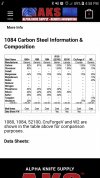Don't forget CPM154, Elmax, 52100 (they call it modified, and designate it as SR101, and their call S7 SR77 and say it is modified for their uses).
They seem to get extreme performance from a toughness standpoint on everything they use.
I've not seen tests results on A8Mod, but the S7 seems to test as very very tough, but loses points on edge retention and corrosion resistance. It also seems to be less stable at thin/acute edges than some other steels (if memory serves correct).
I've hit concrete, brick, and stone with edges. The INFI vs small riverstone (embedded in the bottom of the log I was splitting). INFI ended up handling it like a champ, and I was able to restore the edge to shaving with a round, chromed screwdriver! I split the stone in half, about a dime sized stone. I heard and felt it.
The edge on the Large chopper (FBMLE) was thinned out a good bit thinner than factory.
I've used the old INFI, and the new. They feel different, but that is tough to explain. I've sharpened both, and chopped with both.
I've seen destruction testing with both (they may be on Korean than two versions).
I saw a composition test with supposedly new INFI with no Nitrogen showing in the test, but I don't know at what levels the test would not show nitrogen. It is supposedly less likely to show up in the type of tests used, due to lower atomic weight (but that may be garbage).
http://www.zknives.com/knives/steels/steelgraph.php?nm=infi
I can say I've used Modern Infi, old INFI (some of the earliest). I've also used it at higher hardness than standard. I've been impressed with it in use for choppers, and "hard use". I've damaged it a few times and had surprises ar the ease of fixing it, usually having to remove way less metal to fix than I'm expecting. I've not had any chipping. Only a dent, a nd minor rolling that were fixable, and steeled out (and seemed just as stable as before the damage).
Great corrosion resistance in the satin finish, and in my stripped models.
I've also used Busse and Swamp Rats in SR101 (Busse/Swamprat "modified" 52100) and have been very impressed!!! (Outside the weakest imprint of 52100 which is its penchant for rust/discoloration) I may like it more than Busse's INFI.
I like the higher hardness INGI more than softer run regular infi (
60-62 range vs 58-60 rc). There are some early high hardness Battle Misteresses that had 62 or 63?? Rc.
I've sold off all my INFI, and now have only one Busse, in SR101 (not because I did not love them, but I wanted other toys, including customs in 3V, etc.
I'm no expert.



